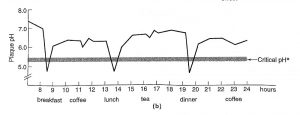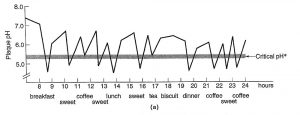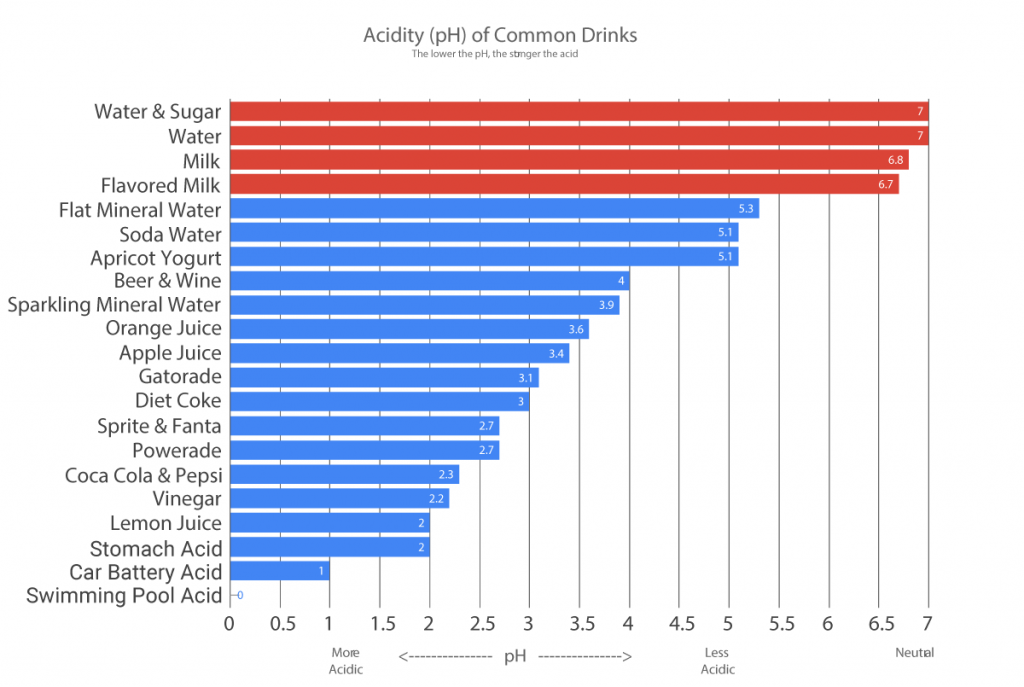UNDERSTANDING AND PREVENTING DENTAL DECAY
June 15, 2017
Dr. Paul Keyes, working at the National Institute of Dental Research (NIDR) in Washington D.C., accepted a referred patient from another dentist. The referring dentist couldn’t understand why the young women had so much dental decay. After questioning her, Dr. Keyes learned that she was a secretary. Every day she took a shot glass of a popular cola drink and set it out on her desk. Throughout the day she wet her mouth with this beverage, causing dental decay throughout her mouth. Why would this habit cause dental decay? This essay will explain the cause of dental decay.
Dental decay is the most chronic disease found in children. Forty-two per cent of children aged 5-17 have had one or more teeth cavities, a hole in a tooth caused by bacterial decay. Left untreated, cavities can be painful, lead to infection, and eventually tooth loss. Dental decay starting on the outside of a tooth can progress to the nerve within a period of three years1. When this occurs, dentistry gets complicated and expensive. When a nerve becomes infected, the treatment frequently involves extraction, or a root canal, crowns, etc. None of this needs to occur if one understands the causes dental decay, makes the necessary preventative lifestyle changes, and sees a dentist every six months.
Dental decay is caused by bacteria. Everyone has bacteria in their mouth. When your teeth are cleaned by a hygienist, bacteria living in the plaque on your teeth are removed. By the time you get home from the dentist’s office, your saliva has laid down a covering of protein on your teeth that bacteria can attach to again. Within a few days, the bacteria will group together and lay down a protective covering over themselves, called a biofilm, which is difficult to penetrate.
When you eat sugary foods or simple carbohydrates, the bacteria consume the carbohydrates for energy and excrete acid. To understand what acid does to teeth, we need to talk about pH which is a scale from 1 to 14 that measures acidity and alkalinity. The pH scale measures acids and alkalis on a scale of 1-14. Lower numbers indicates high acidity. Water has neutral pH of 7.
When pH in the mouth falls below 5.5, minerals come out of the teeth and dental decaiy starts. When you eat a meal, sip a soda or even wet your mouth with soda as the secretary was doing, or eat a piece of candy, the pH in the mouth drops below a pH of 5.5. It remains there until your saliva dilutes the acid and brings the pH back above 5.5 again. It takes your saliva 20-30 minutes to raise the pH and stop the decay process.
The following chart2 shows the drop below a pH of 5.5 from eating three meals a day. There is an hour and half of demineralization, or tooth decay from the normal three meals a day.

The chart below demonstrates the drop in pH, in addition to the usual three meals a day, from snacking, sipping a soda, eating a piece of candy. Minerals are removed from the teeth for four and a half hours in this chart!

The next chart lists the pH of different common drinks. The blue bars represent drinks with a pH below 5.5 A sip of these beverages causes the pH to drop. It takes saliva 20-30 minutes to bring the pH back up past the 5.5 level.

These different beverages provide sugar or simple forms of carbohydrates that are consumed by bacteria in the mouth.
Diet beverages, with no calories, also lower the pH in the mouth. Diet beverages facilitate growth of acid loving bacteria. The diet beverages when consumed routinely change the mouth bacteria from healthy to acid producing bacteria. Diet beverages get part of their good taste from the added acid. Healthy bacteria which can’t tolerate extremely acidic environments are essentially forced out.
Now we can understand why the secretary had a mouth full of decayed teeth; She was continually keeping the decay process going by wetting her mouth with the soda thus keeping the acidity in her mouth below a pH of 5.5. It was not at all surprising to find severe decay throughout her mouth.
It is important to understand that what goes into your mouth between meals can contribute to dental decay. As the secretary story illustrated, it is not wise to continually consume sugar, sodas, snacks, etc. throughout the day if you want healthy teeth.
Research has shown that brushing one’s teeth in the morning and evening and ignoring this acid production by sweets will still lead to dental decay.
Sugar is an addicting substance and it is not easy to stop consuming it.
However, cutting back on snacking can have positive results. Seeing a dentist every six months for a cleaning is another key component in preventing dental decay.
By Donald J. Loomis, DDS
1ADA-Council of Scientific Affairs 2012
2Oral Microbiology, 5th edition, P.D Marsh, M.V. Martin

